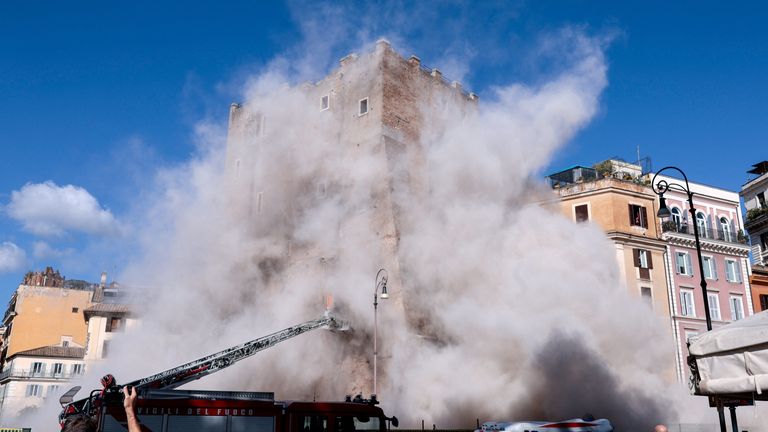A dramatic scene unfolded in the heart of Rome today as a significant portion of the medieval Torre dei Conti collapsed during ongoing restoration works, leaving workers injured and at least one person trapped beneath the rubble. The incident has sent shockwaves through Italy’s cultural heritage community and raised urgent questions about the safety of restoration projects on ancient monuments.
Chaos in the Shadow of the Colosseum
Shortly after 11 a.m. on November 3, 2025, the tranquility of Largo Corrado Ricci—just steps from the Colosseum—was shattered by the sudden collapse of the central buttress on the southern side of the Torre dei Conti. The falling masonry struck several workers, with one 64-year-old man rushed to San Giovanni Hospital in critical condition due to a head injury. Emergency responders reported additional injuries and confirmed that at least one worker remained unaccounted for beneath the debris as rescue operations intensified.
A Second Collapse Caught on Camera
As firefighters and police cordoned off the area and began rescue efforts, a second, even more dramatic collapse occurred just before 1 p.m. This time, both the internal staircase and part of the external wall gave way, sending more debris crashing down—some perilously close to the emergency crews on site. The incident was captured by journalists and television crews who had already gathered at the scene, resulting in a flood of images and videos circulating on news outlets and social media.
Restoration Project Under Scrutiny
The Torre dei Conti, closed to the public since 2007, was undergoing a major restoration funded by nearly €7 million from the EU’s “Caput Mundi” recovery plan. The project aimed to stabilize the structure, restore its historic features, and create new museum and conference spaces. Preliminary work, including asbestos removal and structural testing, had reportedly confirmed the tower’s safety before the main phase of restoration began in June 2025.
Despite these precautions, local reports suggest that unusual noises had been heard coming from the tower in the weeks leading up to the collapse, raising concerns that may not have been fully addressed. The city’s cultural heritage authorities have launched an immediate investigation into the causes of the disaster and the adequacy of safety measures.
What’s Next for the Torre dei Conti?
The area around the tower remains sealed off, with all pedestrian and vehicle traffic halted as rescue and assessment operations continue. The collapse has reignited debate over the challenges of preserving Rome’s ancient landmarks in the face of age, environmental stress, and the complexities of modern restoration.
Authorities have promised a thorough review of all ongoing restoration projects in the city, while cultural heritage experts warn that the Torre dei Conti’s fate could serve as a cautionary tale for similar sites across Italy.
Takeaways and Future Implications
-
Safety in restoration: Even with modern engineering and significant funding, restoring ancient monuments carries unpredictable risks.
-
Cultural loss: The collapse is a stark reminder of the fragility of Rome’s historic treasures and the urgent need for vigilant preservation.
-
Public scrutiny: The abundance of real-time footage and eyewitness accounts will likely fuel public debate and demand for accountability.
As Rome grapples with the aftermath, the world watches to see how the Eternal City will safeguard its past while building for the future.
Sources
1. Roma, crolla la Torre dei Conti ai Fori: operaio disperso sotto ...
2. Sitemap
3. Cedimento di una parte della Torre dei Conti
4. 1-3.pdf - Dipartimento di Architettura - Roma Tre
5. Cosa sappiamo del crollo inaspettato della Torre dei Conti, ...
6. Crollo Torre dei Conti ai Fori Imperiali a Roma, l'allarme ...
7. Roma, le immagini del secondo crollo alla Torre dei Conti
8. Il momento del crollo di parte della Torre dei Conti a Roma
